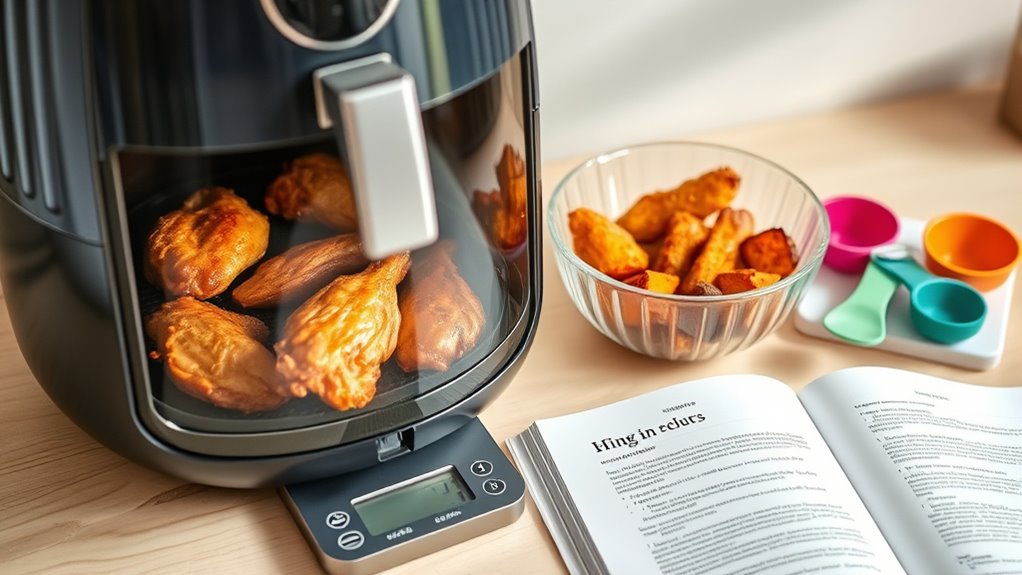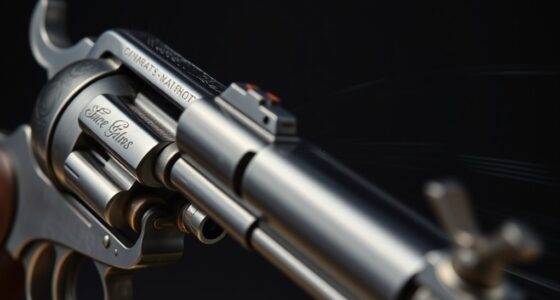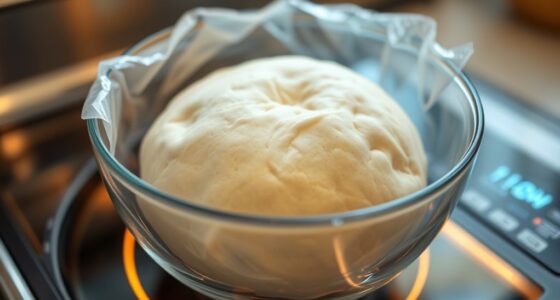When scaling recipes for the air fryer, adjust ingredient amounts proportionally and modify cooking times based on batch size to guarantee even crispiness. Be mindful of your air fryer’s capacity to prevent overloading or underfilling, which affects texture and cooking efficiency. For larger quantities, consider using multiple batches. Small tweaks in timing and spacing make a big difference; keep these tips in mind to perfect your scaled creations as you explore more tricks.
Key Takeaways
- Adjust ingredient quantities proportionally based on the desired serving size to maintain flavor and texture.
- Use appropriate air fryer capacity to prevent overcrowding and ensure even cooking results.
- Modify cooking time by adding 5-10 minutes for larger batches or reducing time by 10-15% for smaller portions.
- Cook in multiple batches if necessary to maintain proper airflow and prevent sogginess or uneven browning.
- Regularly calibrate and monitor temperature settings to ensure accurate cooking when scaling recipes.
Understanding Air Fryer Capacity and Its Impact on Cooking
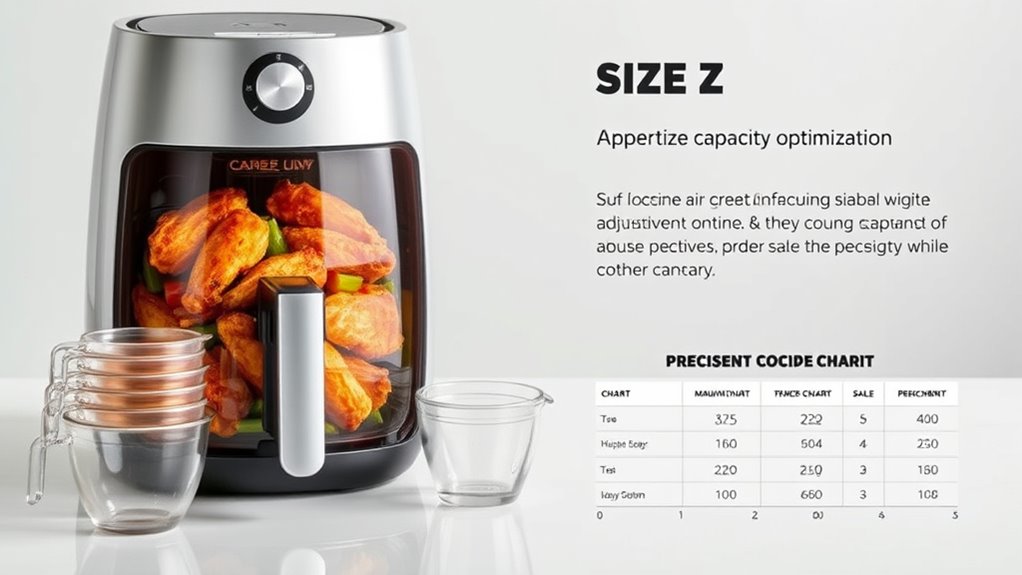
Understanding your air fryer’s capacity is essential because it directly affects how much food you can cook at once. If you overload it, food won’t cook evenly, and you might end up with undercooked or soggy results. Conversely, filling it too sparsely wastes space and doesn’t make the most of its cooking power. Most air fryers range from 2 to 6 quarts, so knowing your model’s size helps you plan portion sizes properly. Smaller units are perfect for single servings or snacks, while larger ones handle family meals. By understanding your capacity, you’ll avoid overcrowding and ensure your food gets crisped and cooked evenly every time. This awareness helps you scale recipes accurately, leading to better results and less waste. Capacity considerations are crucial for optimizing cooking efficiency and avoiding common pitfalls, especially when considering energy consumption and environmental impacts. Additionally, regular cleaning and maintenance of your air fryer can help sustain its performance over time.
Adjusting Cooking Times for Different Batch Sizes

When you change the size of your batch in the air fryer, you’ll need to adjust the cooking times accordingly to guarantee everything cooks evenly. A larger batch may require a few extra minutes, while a smaller one might need less time. Keep in mind that overcrowding can block airflow, leading to uneven cooking. To help, use the table below as a quick reference:
| Batch Size | Adjustment Needed | Tip |
|---|---|---|
| Small (1-2 servings) | Reduce time by 10-15% | Use a single layer for even cooking |
| Medium (3-4 servings) | Follow original time | Shake or flip halfway through |
| Large (5+ servings) | Add 5-10 minutes | Avoid overcrowding for best results |
Additionally, ensuring proper juicing techniques can help maintain consistent cooking results by preventing excess moisture or uneven heat distribution. Proper airflow circulation is essential for achieving evenly cooked dishes, especially when scaling recipes. Incorporating consistent sizing of ingredients can also improve the overall cooking outcome by promoting even heat exposure. Paying attention to air fryer basket arrangement can further enhance heat circulation and cooking uniformity.
Modifying Ingredient Quantities for Accurate Scaling

To guarantee your scaled recipes turn out just right, you need to modify ingredient quantities proportionally. This means calculating the correct amount of each ingredient based on the desired portion size. For example, if you’re halving a recipe, cut all ingredients in half. When increasing the recipe, multiply each ingredient by the scaling factor. Use precise measurements, especially for liquids and spices, to maintain flavor balance. Avoid guessing or eyeballing amounts, as this can throw off the recipe’s consistency. Keep in mind that some ingredients, like baking soda or powder, are sensitive to quantity changes and may require adjustments beyond simple scaling. Additionally, accurate tracking of ingredients and portions can help ensure your dish retains its intended taste, texture, and overall quality regardless of the batch size. Understanding ingredient interactions can further optimize your scaled recipes for the best results.
Tips for Maintaining Texture and Crispiness When Changing Portions

When adjusting your recipe, it’s important to tweak the cooking time to keep foods crispy. Make sure to give each piece enough space in the basket so air can circulate freely. These small changes help preserve that satisfying crunch you’re aiming for.
Adjust Cooking Time
Adjusting cooking time is essential to keep your food crispy and tender when you change portion sizes in the air fryer. When you increase the amount of food, add a few extra minutes to ensure everything cooks evenly without losing crispiness. Conversely, if you’re preparing less food, reduce the cooking time slightly to prevent overcooking or burning. Keep an eye on your food’s color and texture as it cooks, since different quantities may affect heat distribution. It’s helpful to check halfway through the adjusted cooking time and shake or turn the food to promote even crispiness. Remember, small adjustments make a big difference in maintaining that perfect texture you love in air-fried dishes. Additionally, understanding how air circulation impacts cooking can help you better gauge timing adjustments for different portion sizes. Recognizing how portion size influences heat distribution can lead to more precise cooking times and better results, especially when considering cooking temperature variations.
Use Proper Spacing
Ensuring proper spacing between food items in the air fryer is key to maintaining that crispy texture, especially when changing portion sizes. When overcrowded, heat can’t circulate evenly, leading to soggy or unevenly cooked food. To keep your results crispy, leave enough space around each piece for hot air to flow freely. Proper airflow is essential for achieving consistent crispiness and can be influenced by family dynamics and individual behaviors that affect cooking outcomes. Arrange food in a single layer, avoiding overlapping. Use a rack or basket with holes for better airflow. Cook in batches if needed, rather than overcrowding. Shake or flip the food midway to promote even crispiness.
Using Multiple Batches Versus Larger Bans for Quantity Changes

While it might be tempting to cook larger quantities all at once, using multiple batches often yields better results in an air fryer. When you cook in smaller batches, the hot air circulates more evenly around the food, ensuring consistent crispiness and thorough cooking. Overloading a larger pan or basket can block airflow, leading to uneven results and longer cooking times. Although it takes extra time and effort, splitting your ingredients into multiple batches helps maintain ideal texture and flavor. If you’re cooking a large quantity, consider dividing it into manageable portions rather than trying to cook everything at once. This approach allows you to achieve the best quality and prevents sogginess or undercooked spots.
Troubleshooting Common Issues When Scaling Recipes
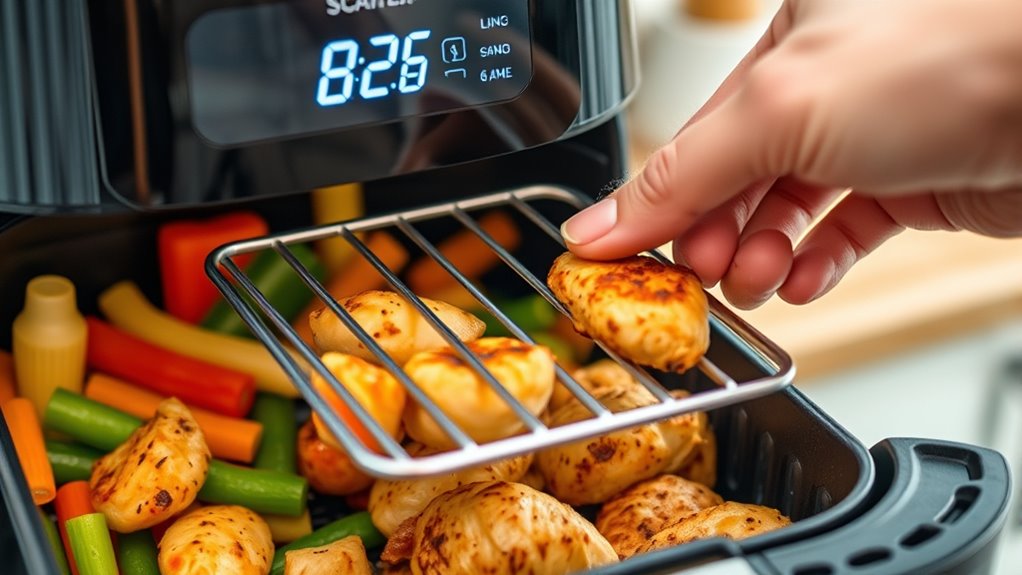
Scaling recipes in an air fryer can sometimes lead to unexpected issues, but most can be resolved with simple troubleshooting. If your food isn’t cooking evenly, try shaking or flipping halfway through. Overcrowding can cause uneven results, so give space between items. If your dish turns out soggy or undercooked, adjust the cooking time or temperature accordingly. Keep in mind that smaller batches might need less time, while larger ones need more. Additionally, incorporating healthy kid play principles such as promoting sharing and cooperation can make cooking sessions more engaging for children involved in meal prep. Understanding asset division considerations like adjusting for different quantities can also help you modify recipes effectively. Paying attention to cooking times and making small adjustments can significantly improve your results. Being aware of proper gadget calibration can help ensure your air fryer operates at the correct temperature for scaled recipes.
Frequently Asked Questions
How Do I Adjust Seasoning Amounts When Scaling Recipes?
When adjusting seasoning amounts, you should start by understanding the original recipe’s ratios. Use a teaspoon or tablespoon measurement for accuracy. For smaller or larger quantities, scale the seasonings proportionally, but taste as you go. Remember, it’s easier to add more seasoning later than to fix an overly salty or spicy dish. Trust your palate, and adjust gradually to achieve the perfect flavor balance.
Can I Reuse Oil When Cooking Smaller or Larger Batches?
You can reuse oil when cooking different batch sizes, but you should be cautious. Strain the oil to remove food particles, which can cause it to spoil faster or smoke during the next use. Keep an eye on the oil’s smell and appearance, and avoid reusing oil multiple times to prevent bad flavors or health risks. Properly stored, a single reuse can be safe and economical.
How Does Altitude Affect Scaled Air Fryer Recipes?
Altitude affects cooking times and temperatures due to lower air pressure. When you cook at higher altitudes, you might notice foods take longer or need higher temperatures to cook properly. For scaled air fryer recipes, adjust your cooking time slightly longer and monitor your food closely. Keep in mind, the air fryer’s sealed environment helps mitigate some altitude effects, but it’s still good to experiment for perfect results at your elevation.
Are There Safety Concerns When Cooking Larger Quantities?
Imagine filling your air fryer basket like a crowded street, overflowing with food. When cooking larger quantities, you might worry about safety, but focus on proper airflow and avoiding overcrowding. You need to guarantee hot air circulates freely, so food cooks evenly and safely. Check your appliance’s capacity, avoid overstuffing, and always monitor cooking progress to prevent accidents, ensuring every batch turns out perfect and safe to enjoy.
How to Prevent Food From Burning When Cooking in Multiple Batches?
To prevent food from burning when cooking in multiple batches, you should monitor cooking times closely and avoid overcrowding the basket. Shake or stir the food halfway through each batch to ensure even cooking. Keep an eye on the temperature setting, lowering it slightly if needed. Allow the air fryer to preheat between batches, and don’t overload it, so heat circulates properly and your food cooks evenly without scorching.
Conclusion
Mastering the art of scaling recipes in your air fryer means balancing batch sizes, adjusting timings, and maintaining tempting texture. With mindful measurements and methods, you’ll masterful manage meals without missing the crispiness or consistency. By blending basic principles with bold experimentation, you’ll confidently create customized culinary creations that cater to any craving. So, seize the skill, streamline your servings, and savor the succulent, satisfying results—successfully scaling your air fryer adventures with savvy, simple steps.
